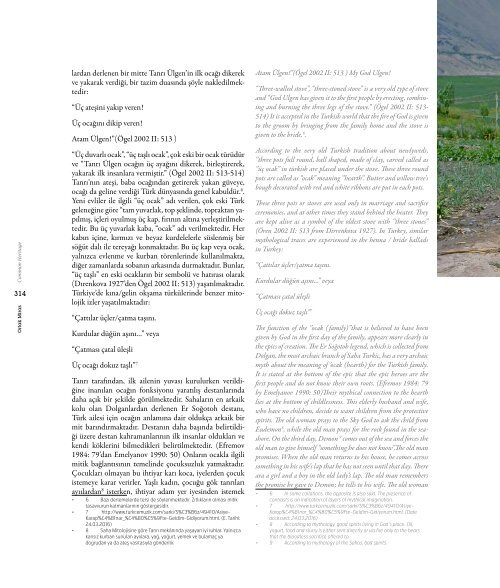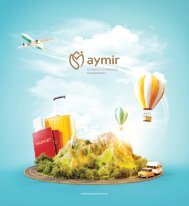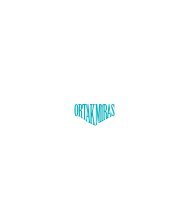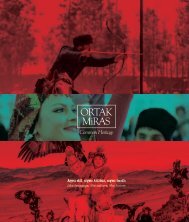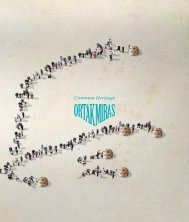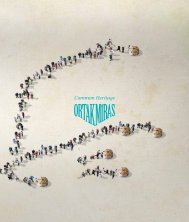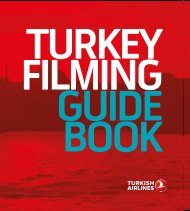Create successful ePaper yourself
Turn your PDF publications into a flip-book with our unique Google optimized e-Paper software.
Common Heritage<br />
314<br />
Ortak Miras<br />
lardan derlenen bir mitte Tanrı Ülgen’in ilk ocağı dikerek<br />
ve yakarak verdiği, bir tazim duasında şöyle nakledilmektedir:<br />
“Üç ateşini yakıp veren!<br />
Üç ocağını dikip veren!<br />
Atam Ülgen!”(Ögel 2002 II: 513 )<br />
“Üç duvarlı ocak”, “üç taşlı ocak”, çok eski bir ocak türüdür<br />
ve “Tanrı Ülgen ocağın üç ayağını dikerek, birleştirerek,<br />
yakarak ilk insanlara vermiştir.” (Ögel 2002 II: 513-514)<br />
Tanrı’nın ateşi, baba ocağından getirerek yakan güveye,<br />
ocağı da geline verdiği Türk dünyasında genel kabuldür. 6 .<br />
Yeni evliler ile ilgili “üç ocak” adı verilen, çok eski Türk<br />
geleneğine göre “tam yuvarlak, top şeklinde, topraktan yapılmış,<br />
içleri oyulmuş üç kap, fırının altına yerleştirilmektedir.<br />
Bu üç yuvarlak kaba, “ocak” adı verilmektedir. Her<br />
kabın içine, kırmızı ve beyaz kurdelelerle süslenmiş bir<br />
söğüt dalı ile tereyağı konmaktadır. Bu üç kap veya ocak,<br />
yalnızca evlenme ve kurban törenlerinde kullanılmakta,<br />
diğer zamanlarda sobanın arkasında durmaktadır. Bunlar,<br />
“üç taşlı” en eski ocakların bir sembolü ve hatırası olarak<br />
(Dırenkova 1927’den Ögel 2002 II: 513) yaşatılmaktadır.<br />
Türkiye’de kına/gelin okşama türkülerinde benzer mitolojik<br />
izler yaşatılmaktadır:<br />
“Çattılar üçler/çatma taşını.<br />
Kurdular düğün aşını…” veya<br />
“Çatması çatal üleşli<br />
Üç ocağı dokuz taşlı” 7<br />
Tanrı tarafından, ilk ailenin yuvası kurulurken verildiğine<br />
inanılan ocağın fonksiyonu yaratılış destanlarında<br />
daha açık bir şekilde görülmektedir. Sahaların en arkaik<br />
kolu olan Dolganlardan derlenen Er Soğotoh destanı,<br />
Türk ailesi için ocağın anlamına dair oldukça arkaik bir<br />
mit barındırmaktadır. Destanın daha başında belirtildiği<br />
üzere destan kahramanlarının ilk insanlar oldukları ve<br />
kendi köklerini bilmedikleri belirtilmektedir. (Efremov<br />
1984: 79’dan Emelyanov 1990: 50) Onların ocakla ilgili<br />
mitik bağlantısının temelinde çocuksuzluk yatmaktadır.<br />
Çocukları olmayan bu ihtiyar karı koca, iyelerden çocuk<br />
istemeye karar verirler. Yaşlı kadın, çocuğu gök tanrıları<br />
ayıılardan 8 isterken, ihtiyar adam yer iyesinden istemek<br />
• 6 Bazı derlemelerde tersi de söylenmektedir. Zıtlıkların olması mitik<br />
tasavvurun katmanlarının göstergesidir.<br />
• 7 http://www.turkcemuzik.com/sarki/S%C3%B6z/49410/Asiye-<br />
Karap%C4%B1nar_%C4%B0%C5%9Fte-Geldim-Gidiyorum.html. (E. Tarihi:<br />
24.03.2016)<br />
• 8 Saha Mitolojisine göre Tanrı mekânında yaşayan iyi ruhlar. Yalnızca<br />
kansız kurban sunulan ayıılara, yağ, yoğurt, yemek ve bulamaç ya<br />
doğrudan ya da ateş vasıtasıyla gönderilir.<br />
Atam Ülgen!”(Ögel 2002 II: 513 ) My God Ulgen!<br />
“Three-walled stove”, “three-stoned stove” is a very old type of stove<br />
and “God Ulgen has given it to the first people by erecting, combining<br />
and burning the three legs of the stove.” (Ögel 2002 II: 513-<br />
514) It is accepted in the Turkish world that the fire of God is given<br />
to the groom by bringing from the family home and the stove is<br />
given to the bride. 6 .<br />
According to the very old Turkish tradition about newlyweds,<br />
‘’three pots full round, ball shaped, made of clay, carved called as<br />
‘’üç ocak’’ in türkish are placed under the stove. These three round<br />
pots are called as “ocak” meaning ‘’hearth’’. Butter and willow tree’s<br />
bough decorated with red and white ribbons are put in each pots.<br />
These three pots or stoves are used only in marriage and sacrifice<br />
ceremonies, and at other times they stand behind the heater. They<br />
are kept alive as a symbol of the oldest stove with ‘’three stones’’<br />
(Ören 2002 II: 513 from Dirrenkova 1927). In Turkey, similar<br />
mythological traces are experienced in the henna / bride ballads<br />
in Turkey:<br />
“Çattılar üçler/çatma taşını.<br />
Kurdular düğün aşını…” veya<br />
“Çatması çatal üleşli<br />
Üç ocağı dokuz taşlı” 7<br />
The function of the ‘’ocak ( family)’’that is believed to have been<br />
given by God in the first day of the family, appears more clearly in<br />
the epics of creation. The Er Soğotoh legend, which is collected from<br />
Dolgan, the most archaic branch of Saha Turkic, has a very archaic<br />
myth about the meaning of ’ocak (hearth) for the Turkish family.<br />
It is stated at the bottom of the epic that the epic heroes are the<br />
first people and do not know their own roots. (Efremov 1984: 79<br />
by Emelyanov 1990: 50)Their mythical connection to the hearth<br />
lies at the bottom of childlessness. This elderly husband and wife,<br />
who have no children, decide to want children from the protective<br />
spirits. The old woman prays to the Sky God to ask the child from<br />
Eudemon 8 , while the old man prays for the rock found in the seashore.<br />
On the third day, Demon 9 comes out of the sea and forces the<br />
old man to give himself “something he does not know”.The old man<br />
promises. When the old man returns to his house, he comes across<br />
something in his wife’s lap that he has not seen until that day. There<br />
ara a girl and a boy in the old lady’s lap. The old man remembers<br />
the promise he gave to Demon; he tells to his wife. The old woman<br />
• 6 In some collations, the opposite is also said. The presence of<br />
contrasts is an indication of layers of mythical imagination.<br />
• 7 http://www.turkcemuzik.com/sarki/S%C3%B6z/49410/Asiye-<br />
Karap%C4%B1nar_%C4%B0%C5%9Fte-Geldim-Gidiyorum.html. (Date<br />
accessed: 24.03.2016)<br />
• 8 According to mythology, good spirits living in God’s place. Oil,<br />
yogurt, food and slurry is either sent directly or via fire only to the bears<br />
that the bloodless sacrifice offered to.<br />
• 9 According to mythology of the Sahas, bad spirits.


